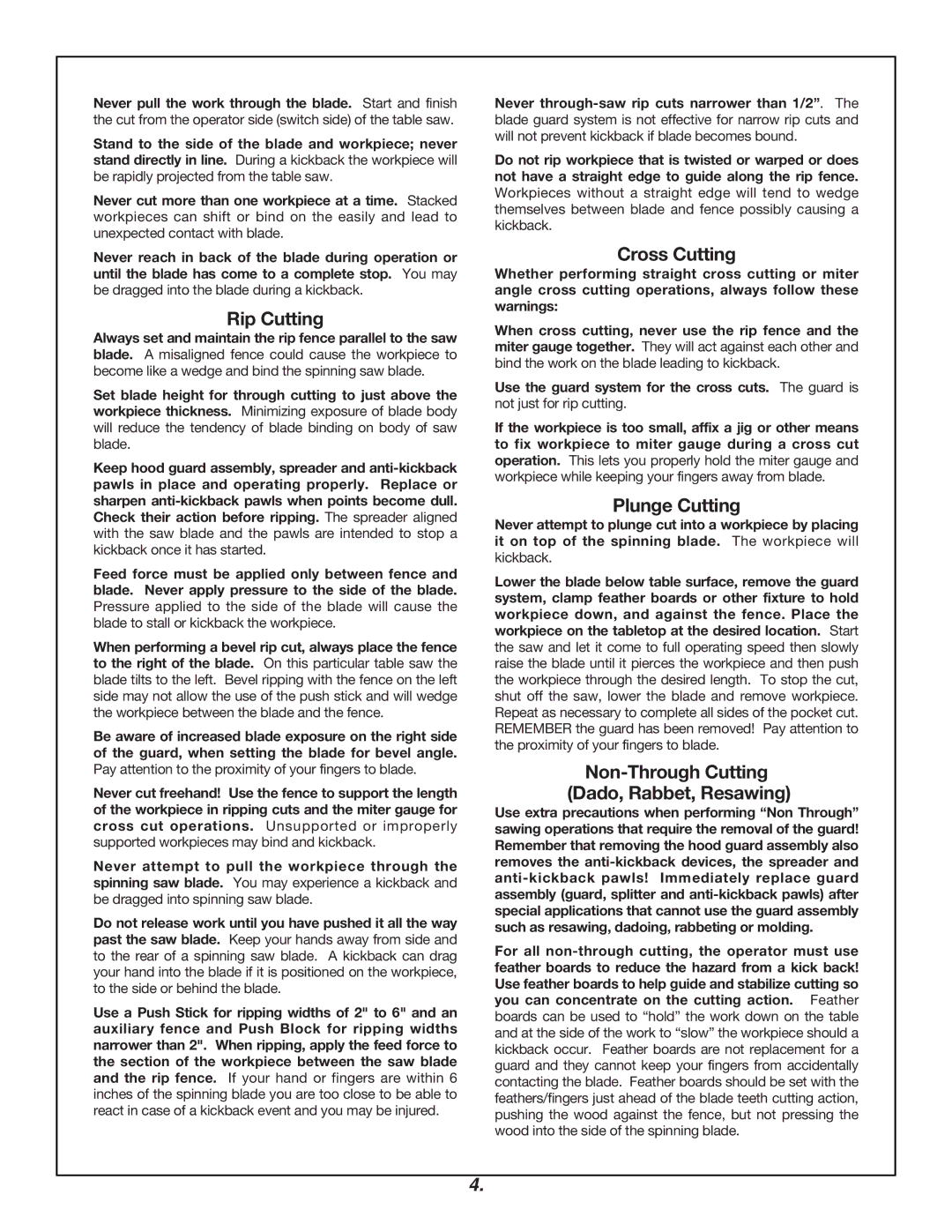
Never pull the work through the blade. Start and finish the cut from the operator side (switch side) of the table saw.
Stand to the side of the blade and workpiece; never stand directly in line. During a kickback the workpiece will be rapidly projected from the table saw.
Never cut more than one workpiece at a time. Stacked workpieces can shift or bind on the easily and lead to unexpected contact with blade.
Never reach in back of the blade during operation or until the blade has come to a complete stop. You may be dragged into the blade during a kickback.
Rip Cutting
Always set and maintain the rip fence parallel to the saw blade. A misaligned fence could cause the workpiece to become like a wedge and bind the spinning saw blade.
Set blade height for through cutting to just above the workpiece thickness. Minimizing exposure of blade body will reduce the tendency of blade binding on body of saw blade.
Keep hood guard assembly, spreader and
Feed force must be applied only between fence and blade. Never apply pressure to the side of the blade. Pressure applied to the side of the blade will cause the blade to stall or kickback the workpiece.
When performing a bevel rip cut, always place the fence to the right of the blade. On this particular table saw the blade tilts to the left. Bevel ripping with the fence on the left side may not allow the use of the push stick and will wedge the workpiece between the blade and the fence.
Be aware of increased blade exposure on the right side of the guard, when setting the blade for bevel angle. Pay attention to the proximity of your fingers to blade.
Never cut freehand! Use the fence to support the length of the workpiece in ripping cuts and the miter gauge for cross cut operations. Unsupported or improperly supported workpieces may bind and kickback.
Never attempt to pull the workpiece through the spinning saw blade. You may experience a kickback and be dragged into spinning saw blade.
Do not release work until you have pushed it all the way past the saw blade. Keep your hands away from side and to the rear of a spinning saw blade. A kickback can drag your hand into the blade if it is positioned on the workpiece, to the side or behind the blade.
Use a Push Stick for ripping widths of 2" to 6" and an auxiliary fence and Push Block for ripping widths narrower than 2". When ripping, apply the feed force to the section of the workpiece between the saw blade and the rip fence. If your hand or fingers are within 6 inches of the spinning blade you are too close to be able to react in case of a kickback event and you may be injured.
Never
Do not rip workpiece that is twisted or warped or does not have a straight edge to guide along the rip fence. Workpieces without a straight edge will tend to wedge themselves between blade and fence possibly causing a kickback.
Cross Cutting
Whether performing straight cross cutting or miter angle cross cutting operations, always follow these warnings:
When cross cutting, never use the rip fence and the miter gauge together. They will act against each other and bind the work on the blade leading to kickback.
Use the guard system for the cross cuts. The guard is not just for rip cutting.
If the workpiece is too small, affix a jig or other means to fix workpiece to miter gauge during a cross cut operation. This lets you properly hold the miter gauge and workpiece while keeping your fingers away from blade.
Plunge Cutting
Never attempt to plunge cut into a workpiece by placing it on top of the spinning blade. The workpiece will kickback.
Lower the blade below table surface, remove the guard system, clamp feather boards or other fixture to hold workpiece down, and against the fence. Place the workpiece on the tabletop at the desired location. Start the saw and let it come to full operating speed then slowly raise the blade until it pierces the workpiece and then push the workpiece through the desired length. To stop the cut, shut off the saw, lower the blade and remove workpiece. Repeat as necessary to complete all sides of the pocket cut. REMEMBER the guard has been removed! Pay attention to the proximity of your fingers to blade.
Non-Through Cutting
(Dado, Rabbet, Resawing)
Use extra precautions when performing “Non Through” sawing operations that require the removal of the guard! Remember that removing the hood guard assembly also removes the
For all
4.
